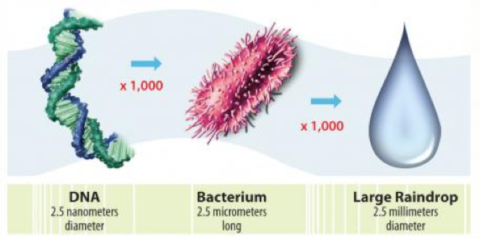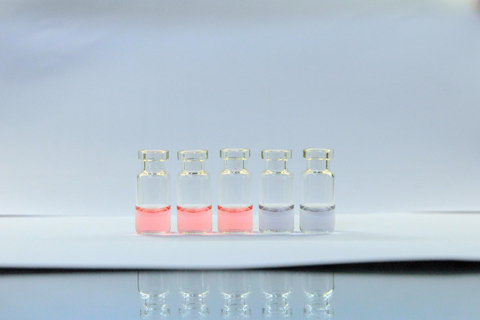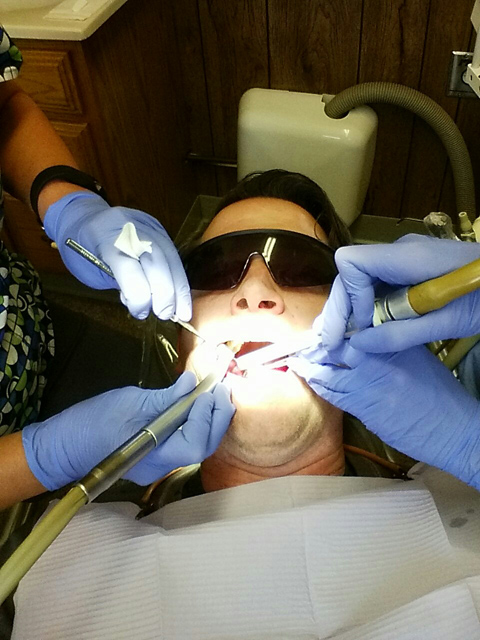Nanodentistry: Big Impacts from Small Science
Imagine your toothpaste contains an army of tiny cleaning robots. You brush, rinse, and spit, but the robots keep on working. They travel around, metabolizing the leftover pizza and soda scum on the surface of your teeth into harmless, odorless vapors. They fight off all of the decay-causing bacteria and then, mission complete, deactivate and pass on to the next life.
These “nanorobots” are still hypothetical, but they are one of many possibilities that emerge when you design tools, materials, and even robots on the scale of atoms—possibilities that include reducing the anxiety, fear, and pain that millions of people associate with the dentist. And, strangely enough, doing so by applying physics—a subject that also causes anxiety and fear for many people.
A dentist’s office may seem primitive, with the drilling and tooth pulling, but most dentists rely on pretty sophisticated scientific tools. For example, lasers are now commonly used to treat gum disease and ulcers, prepare teeth for fillings, and perform oral surgeries. Many of these procedures are more accurate and less painful when done with a laser than with traditional methods. Dentistry has come a long way since the pre-Enlightenment days, when people in many cultures believed that cavities were holes bored by tooth worms.
Nanodentistry is a new and growing field that merges nanotechnology with dentistry. Objects on the nanoscale are measured in nanometers and are extremely tiny, around the width of DNA. Just one inch is 25.4 million nanometers.

When you zoom in to this level, things get weird. The properties of a material – like color and melting point – depend on the size of the particle, they aren’t intrinsic to the material like they are on the visible scale. For example, gold nanoparticles of different sizes interact with light differently. Solutions made with gold nanoparticles of different sizes are different colors. At the nanoscale you can engineer a material to have a specific property by changing its size.

Solutions of gold nanoparticles of various sizes. The size difference causes the difference in colors.
Teeth are way off the nanoscale charts, but many biological process take place on that scale. This is the world of atoms (0.1-0.3 nm), proteins (3-6 nm), viruses (30-50 nm), and many cellular processes. Understanding physics at the nanoscale enables us to design devices and structures that interact with these biological processes in new and targeted ways.
Good dental care is a combination of preventing problems, treating problems, and making your smile look good. Nanodentistry is leading to improvements all of these areas through new products and techniques. Some are already available while others are in various stages of development and testing.
On the Market
Archeological evidence suggests that ancient Greeks may have treated cavities with linen soaked in medicine, and a cavity in a tooth 65-centuries old is still packed with beeswax. For the last 150+ years, most cavities have been filled with amalgam, a mix of silver, tin, copper, mercury, and small amounts of other metals.

In Development
Researchers are exploring a long list of ways that nanotechnology could make your visit to the dentist more comfortable, and make the result more effective and attractive. For example:
- Delivering therapeutic drugs like antibacterials or chemotherapy with nanoparticles or nanorobots that go straight to the source, enabling smaller doses and reducing side effects.
- Taking high quality images of your mouth with lower levels of radiation.
- Creating dental implants that mimic the nanoscale features of natural bone and interact better with connecting bone and tissue.
- Strengthening and whitening teeth by inserting nanomaterials with these properties into the outer layers of enamel.
- Sending a particular molecule to the site of a dental implant, bone surgery, or tooth decay that tells the cell to initiate repair.
- Designing nanorobots to clean teeth and perform other functions, such as sealing exposed channels, called tubules, on teeth that cause hypersensitivity to hot or cold. Other functions might include delivering local anesthesia (no more long needles!) or providing painless, quick orthodontic services.
Dentistry has come a long way from beeswax fillings, with many exciting advances on the horizon. Scientists with backgrounds in nanoscience, chemistry, physics, biology, and medicine are working together, forming companies and research collaborations that aim to turn these possibilities into dentist office realities—realities that will hopefully make your life a little more comfortable, your smile a little brighter, and your teeth healthier and more durable.














